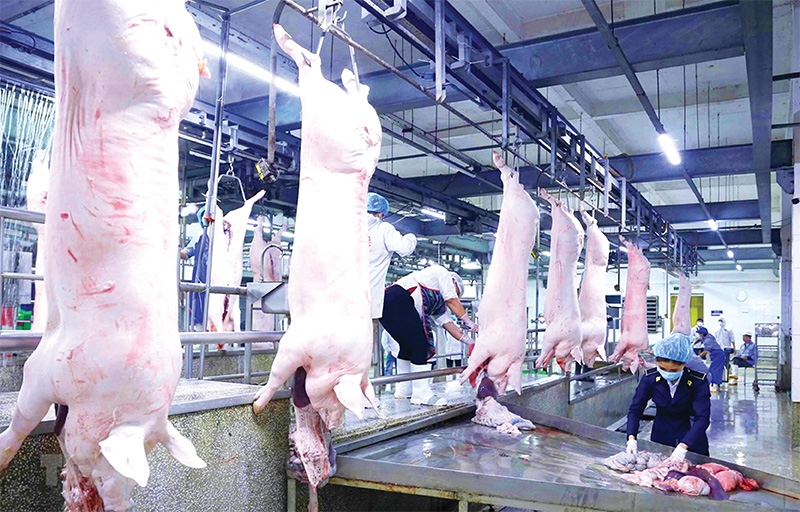Rush of high-tech breeders expanding into Vietnam
 |
| A series of new breeding and processing facilities are popping up across Vietnam,Photo: Linh Le |
Hung Nhon Group and Dutch group De Heus are currently developing a VND1 trillion ($44 million) high-tech agricultural complex in the Central Highlands province of Gia Lai.
Covering an area of 100 hectares, the complex will host a complete production chain, including breeding facilities for pigs, slaughter, and the manufacturing of organic feed and fertiliser meeting international standards. The entire complex will be designed using advanced agricultural technology.
Half of the facility will be used to breed around 2,500 pigs imported from the Netherlands. The remaining area is to serve the remaining components of the project.
In May 2019, both investors signed an MoU with Daklak People’s Committee to develop the DHN Daklak high-tech agricultural complex. The construction has been implemented on schedule and is expected to be completed in the fourth quarter of 2025. The planned complex in Gia Lai is similar to another one already based in Daklak.
The complex in Daklak includes an 80ha farm for breeding 2,400 imported from the Netherlands; a 30ha chicken breed area; and a 15ha plant for slaughtering and organic fertiliser production.
Asked about the wastewater treatment system, Dao Duy Bien, general director of DHN Daklak High Tech Agriculture Development JSC, told VIR, “We spent 5-10 per cent of the total investment capital building this system. The entire machine line and technology will be imported from Germany, Denmark, and the Netherlands.”
“Fertiliser manufacturing plants can help limit the discharge of waste into the environment. In addition, the treated water will be recycled thoroughly,” Bien said.
Following establishment of the Gia Lai complex, the two groups plan to develop further breeding facilities in Daklak, Kon Tum, and Lam Dong provinces.
Bien, who is also a member of Hung Nhon Group, told VIR that the products of these farms are expected to be exported to all of Southeast Asia. “De Heus and Hung Nhon aim to expand pig farming across five Central Highlands provinces over the next 5-10 years. These projects are hoped to turn the Central Highlands into a hub of pig farming in Southeast Asia,” Bien said.
In early June, one investment promotion and consultancy company began to survey possible investment destinations for a foreign partner to develop pig breeding and processing plants for export with a total investment capital of $1.5 billion.
According to its plan, the project would cover an area of over 1,200ha with six components, including a 30ha genetic centre, three breeding centres over 90ha, a cattle feed plant (10ha), three mixed processing plants (127ha), three pork processing factories (127 ha), and 43 pig breeding farms (860ha).
Meanwhile, C.P. Vietnam, Japfa, and Group JSC also plan to expand operations here. The groups confirmed that husbandry is one of the most risky sectors due to the possible impact of diseases. However, the continuous expansion of these groups in spite of all risks is showing that the cattle and poultry breeding sector offers huge profit. In recent times, these companies reported both strong revenue and profit despite the pandemic.
Dabaco, a multi-field group specialising in animal feed, cattle, and poultry breeding, is an example for the sector’s speed of growth. In the first half of the year, the group gained VND744 billion ($32.35 million) in profit, 27 times as much as in the year before and surpassing the annual plan by 63 per cent.
This year, the company targets to earn VND13.2 trillion ($574 million) in revenue and VND512 billion ($22.26 million) in after-tax profit. At the 2020 shareholders’ meeting two months ago, Nguyen Nhu So, chairman of the Board of Directors, stated that the group’s profit could well reach its charter capital of VND911 billion ($39.6 million) in the current market, and it is firmly on track to reaching the targets.
What the stars mean:
★ Poor ★ ★ Promising ★★★ Good ★★★★ Very good ★★★★★ Exceptional
Related Contents
Latest News
More News
- Ho Chi Minh City hits $8.37 billion in FDI (December 29, 2025 | 08:28)
- Tax sector wraps up 2025 and sets priorities for next year (December 25, 2025 | 14:00)
- Heavy industries set for pilot greenhouse gas quotas (December 25, 2025 | 10:00)
- $250 million deal targets women-owned SMEs, sustainable agriculture (December 22, 2025 | 17:40)
- UOB sees Vietnam growth easing in fourth quarter (December 22, 2025 | 17:39)
- Government moves to establish International Financial Centre (December 21, 2025 | 21:00)
- Vietnam's IFC to target global investment flows (December 21, 2025 | 18:00)
- Ha Tinh breaks ground on major Vingroup industrial and energy projects (December 19, 2025 | 18:24)
- EVN launches major power infrastructure projects nationwide (December 19, 2025 | 18:17)
- VAL inaugurates second production line to meet domestic animal feed demand (December 19, 2025 | 16:37)

 Tag:
Tag:





















 Mobile Version
Mobile Version